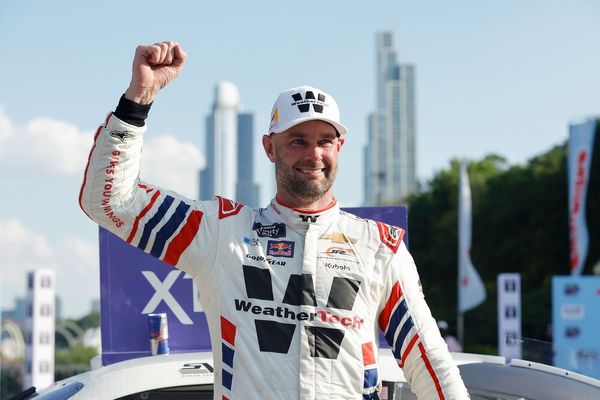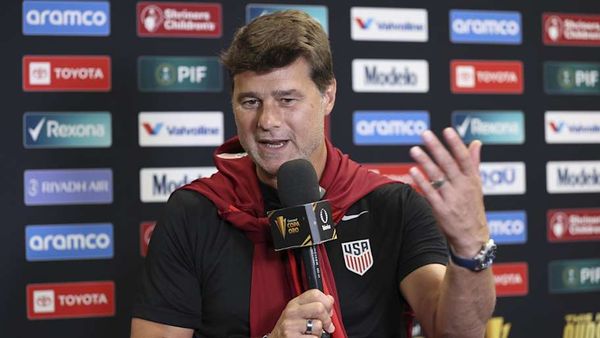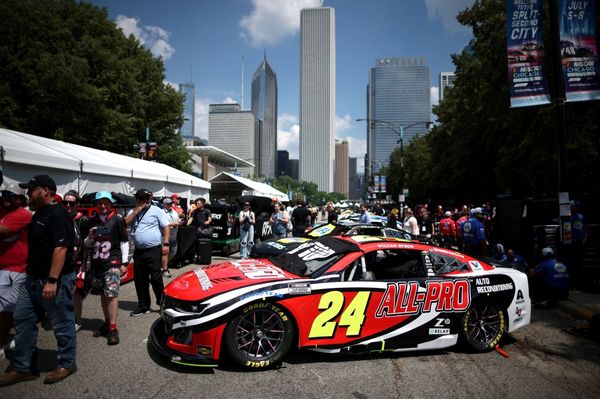
Grand, ungainly and defiantly young – this is the art of Rose Wylie. It is a strange and anomalous combination, especially since she is now 83. Looking at her enormous canvases, which might show a park bench, a film star surrounded by flying ears or a biscuit on its way into someone’s open mouth, you reel at the sheer directness of the painting, presented with all the primitive force of a child’s drawing. Her works are crude and joyous, and as awkward as she wants them to be.
They are also catnip for collectors, critics and students alike. Wylie found fame late, winning the Paul Hamlyn, Charles Wollaston and John Moores prizes for painting in her 70s and 80s. Born in Kent, where she still lives, her career was interrupted by motherhood for many years, and she only completed her MA at the age of 47. The earliest work in this retrospective dates only as far back as 1997 – a yellow bird peering out of some clumsily painted branches, but at just the right angle to show its fledgling wariness – and her style has scarcely changed ever since.
Ray’s Yellow Plane shows a sun-bright aircraft soaring down an unprimed canvas, yellow and orange paint pressed hard into the fabric and so thick you could practically lift the plane off the surface. Pink Skater presents a woman in sugar-pink costume, orange stars bursting all around her, held in a leap so expansive it straddles two canvases. Her frozen smile echoes the thought bubble Will I Win, running like a newsflash below. It is a jubilant and preposterous scenario.
Here and there, Wylie has added a bit more canvas or watercolour paper at the last minute, hastily improvising as she goes. The pictures carry drips and globs, as if worked on the floor and then upended. You can see where the heavily laden brush eventually runs out, or where a whole paint tube has been squeezed on to the surface and worked like wet plaster across the surface. The subject matter might seem modest – a pineapple, two flowers – but the monumental materiality of the paint slows it all down. They are like rapid observations writ large.
Or perhaps they are recollections. For the Serpentine Sackler Gallery, Wylie has painted memories of Kensington Gardens during the blitz, featuring this very building. Dogs scramble merrily about in the gloaming beneath whirring German planes. Two yellow ducks, straight out of a bath, stand in for the local fowl. This a seven-year-old’s vision of the park, curious and without any fear.

The painting is gleefully coarse. Like the huge man with his knees carelessly splayed, dwarfing the park bench on which he sits; or the wine-dark sky, a banana moon hanging above another wonky bench in bright green. Pick your own colour, runs the wording below, as if everything could be readily changed. Spontaneity is crucial to her look.
And the look trips you up every time. It carries the image with outright candour (and the influences too: Wylie’s admiration for Philip Guston and the neo-expressionists is openly declared), and then it asks you to consider why on earth she would choose to paint like this. These pictures are not quite cartoons, although they deploy the language of caricature – explosion marks, tiny legs and big heads, and so on – and nor are they knowing pastiches of children’s art. There is huge relish in the jaunty outlines, the exhilaration of colour and the material characteristics of paint. They allow Wylie, at best, a kind of laconically humorous timing.

A two-picture sequence shows an acorn on one side and a jay on the other, trying desperately to force his beak into the next frame, as if it actually contained food. The tightrope balanced by an acrobat with a tiny pursed mouth really is tight, barely a couple of inches wide. There is the queer intimation of a clock in the dragonfly’s head, as if measuring his one precious day of life. Comparatively small, and in watercolour, these paintings are epigrammatic where the biggest friezes are not. The comedy of her art has at least something to do with the balance between scale and content.
The curators of this show are putting considerable emphasis on Wylie’s film paintings, based on scenes from particular movies, and on the cinematic aspects of her art, which aren’t obvious to me. Certainly there are focus pulls; two pictures show a pink-draped table in a desert, in closeup and then at distance, in a kind of comic jump. But it feels quite irrelevant that the film is Syriana, or that it stars George Clooney, as inscribed in wobbly block capitals below.

Nor is it quite clear – visually or intellectually – what drew Wylie to paint a frame from Kill Bill, or a vast frieze of caryatids in red dresses, except that a note scribbled on the canvas refers to the Cannes premiere of The Paperboy, notoriously booed, at which Nicole Kidman wore red.
What engaged Wylie doesn’t emerge in these works. The subject matter hasn’t become entirely her own. Look instead at the abrupt and outlandish painting of Elizabeth I, based on Marcus Gheeraerts’ famous “Ditchley portrait”. Wylie gives Gloriana a head like a ginger lightbulb, briskly apt, and surrounds her with some humble pansies, yellow and purple, enlarged until they become almost overpoweringly heraldic. The juxtaposition is so sudden it becomes comic; like many kinds of humour, however, it doesn’t bear too much analysis.
• Rose Wylie: Quack Quack is at the Serpentine Sackler Gallery, London until 11 February







